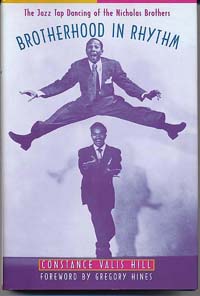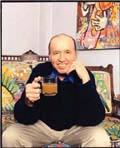NEW YORK JAZZ TRACKS
(To hear this streaming music, simply click on the links below. If you don't already have the extremely useful RealPlayer software utility on your computer, go here for a safe and painless download of the free version.)
RECENTLY ADDED TRACKS
Like gospel music?
Here’s a stirring anthem called
Said I Wasn't Gonna Tell Nobody by the choir at Abyssinian
Was Louis
Jordan the original rapper? With novelty tunes like
Chartreuse, he and his Tympany Five used to bring down the house at
the Elks Rendezvous, a club on
Fletcher Henderson’s band cut Freeze and Melt (replete with banjo and tuba) in the late Twenties. Fletcher and his wife owned a house along beautiful Striver’s Row, as did W.C. Handy, Eubie Blake and many other notables.
Who else but Louis Armstrong could take a ditty like I'm a Ding-Dong Daddy and make a classic out of it?
The Duke Ellington band recorded Harlem Airshaft in the late Thirties, with a surprising number of soloists having their say in under three minutes.
Sure, you've heard "I Got Rhythm" thousands of times. But have you heard He Ain't Got Rhythm? This is the Jimmy Lunceford band's version.
Andy Kirk cut Puddin' Head Serenade during the period when Mary Lou Williams was his band's pianist and chief arranger.
Happily, Count Basie's 1939 Tickle Toe allows us the chance to hear lots of Lester Young's tenor saxophone work.
It's a favorite of chiropodists everywhere: Fats Waller's rendering of Your Feet's Too Big.
Billie Holiday’s Twenty-Four Hours a Day dates from the time when she was already a popular attraction at Harlem joints like Pod & Jerry’s Catagonia Club. On the other hand, if you prefer Middle-Period Billie, check out these five tracks recorded for the Decca label during the late 40s: That Old Devil Called Love...Do Your Duty...Good Morning, Heartache... Lover Man...and No More.
AUDIO FEATURES
Harlem stride piano master Willie “The Lion” Smith was also one of the great jazz raconteurs. This track features Willie talking with writer Leonard Feather about his old friend Fats Waller – and then playing his own version of a Waller classic.
Finally! There's now an impressive bronze tablet marking the former location of the famed Savoy Ballroom on Lenox Avenue. After you've perused a detailed history of good times at the Savoy, listen to music and memories from this celebrated Harlem nightspot, accessed through the Ken Burns Jazz website. Next, a 1938 version of Liza demonstrates why Chick Webb's band ruled the roost during the Savoy's heyday. To round thing out, here's a 2002 treatment of Stompin' at the Savoy recorded live at Birdland by guitarist John Pizzarelli's trio.
 The
famed Nicholas Brothers –
dancers extraordinaire –
resided for many years in an
apartment on Harlem's Sugar Hill. Once you've read a 1998
interview
with brother Fayard...and checked a
review of a fine new bio of the pair...you can hear them on
their 1936 recording of
Keep a Twinkle in Your Eye. Harold Nicolas handles the vocal while
Fayard taps.
The
famed Nicholas Brothers –
dancers extraordinaire –
resided for many years in an
apartment on Harlem's Sugar Hill. Once you've read a 1998
interview
with brother Fayard...and checked a
review of a fine new bio of the pair...you can hear them on
their 1936 recording of
Keep a Twinkle in Your Eye. Harold Nicolas handles the vocal while
Fayard taps.
So who was Charlie Parker? Most enthusiasts rank him (along with Armstrong and Ellington) as one of the three most influential figures in jazz. In fact, National Public Radio included Parker's 1945 recording of "Ko-Ko" on its list of the 100 greatest recorded performances in American music. Clicking here will take you to an NPR/Ken Burns website containing four brief audio features on the man and his influence. Ever hear Bird's mellifluous speaking voice? Here's a chance to do just that.
By any measure, "A Love Supreme" is one of the most enduring (and influential) of jazz recordings. In fact, an entire book on just this one Coltrane session and its background was recently published. Here's a 51-minute broadcast feature on the making of the album, originally aired by WBUR in Boston.
Although he grew up in St. Paul and now lives on the West Coast, many of the songs written and sung by pianist Dave Frishberg have a decidedly New York attitude. (Dave lived for years in Greenwich Village.) Here's an interview with him, conducted by NPR's Terry Gross. Then enjoy two of Dave's most requested tunes: Blizzard of Lies and My Attorney Bernie.
POETRY-AND-JAZZ
During our Harlem tour, we pass the W. 127th St. apartment where Langston Hughes resided for the last twenty years of his life. Go here for 44 delightful minutes of Hughes reading his own poetry with jazz backing. (Incidentally, the second half of this rare 1958 album features accompaniment by a sterling Charles Mingus quintet.)
OUR MAN BOB
 Singer/pianist/songwriter
Bob Dorough celebrated his eighty-second birthday last December twelfth.
Click
here for 32 complete tracks highlighting Bob's talent, versatility
and warmth.
Singer/pianist/songwriter
Bob Dorough celebrated his eighty-second birthday last December twelfth.
Click
here for 32 complete tracks highlighting Bob's talent, versatility
and warmth.
YET MORE FINE STUFF
Guitarists
Eddie Lang and Lonnie Johnson cut
Two-Tone Stomp in 1928.
Never Swat a Fly is a droll admonition from McKinney's Cotton
Pickers. This one was recorded in 1930.
James P. Johnson, king
of the
Vibraphonia, dating from 1933, features the incredibly versatile Adrian Rollini on bass saxophone, vibes, piano and hot fountain pen, with Jimmy Dorsey tripling on trumpet, alto saxophone and clarinet. Violinist Joe Venuti and guitarist Dick McDonough are also aboard.
Jazz fiddler Stuff Smith and trumpeter Jonah Jones were the toast of 52nd St. (the original Swing Street) when this 1936 record of You'se a Viper was issued. Now you'll understand why.
Who even knew that Rochester could sing? This is Eddie Anderson's distinctive 1940 treatment of Waiting for Jane. He was a featured attraction for years at Harlem's Apollo Theater.
They say that Billy Eckstine's big band was the first large bebop ensemble. The real star on this 1947 track called I Love the Rhythm in a Riff is Budd Johnson's forward-looking arrangement.
More proto-bebop from 1947: The Tadd Walk. This Tadd Dameron quintet track has Fats Navarro on trumpet and Ernie Henry playing alto.
Moms Mabley's and Pearl Bailey's delightful 1949 recording of Saturday Night Fish Fry is a certified gem. But this alternate take, released only years later, will tickle you even more. Obviously, everyone was in high spirits during this recording session.
Coleman Hawkins lived for decades in the Sugar Hill neighborhood we explore on our Harlem walk. Here’s a 1958 track called Bird of Prey Blues taken at just the right tempo: long solos by Hawkins on tenor, Buck Clayton on trumpet, Hank Jones playing piano, a drummer named Mickey Sheen and some superb bass work by Ray Brown throughout.
Ellington composed Black Beauty to celebrate Twenties musical star Florence Mills. This 1999 treatment of Duke’s piece was recorded live at Birdland by the Copenhagen-based ensemble known as Pierre Dorge & New Jungle Orchestra.